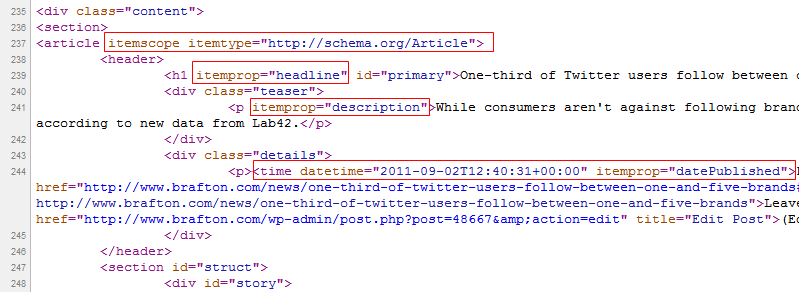Search engine optimization (or SEO, for short) is the process of formatting the HTML markup and raw content of a website or web page such that search engines correctly understand its content.
Meta Tags
Of all the methods available, meta tags such as “title”, “description” and “keywords” are fundamental. In recent months, the meta “keywords” have become less important for the subject matter of a web page, but some search engines may still pay attention to the tag.
- Title: Expressed as
<title>Your Title Here</title>
in the document
<head>
; used by search engines as the headline for your page in search results and is analyzed for keywords
- Description: Expressed as
<meta name="description" value="Your Description here." />
in the document
<head>
; most search engines only show up to the first ~155 characters in search results and use this tag as the basis for identifying primary keywords in the content.
- Keywords: Expressed as
<meta name="keywords" value="keyword1, keyword2, etc." />
in the document
<head>;
rarely used in modern SEO, but can more specifically target KWPs
On-page SEO
The next layer of proper SEO implementation is what is referred to as “on-page SEO” or optimization within the content itself. There are a variety of ways to target specific search keywords:
- Bolded text: When text is wrapped in “b” or “strong” tags, it signals to the search crawler that the snippet within is significant to the article’s meaning and places higher priority. If you want to visually bold a phrase without affecting on-page SEO, you can do so with CSS styling, such as
<span style="font-weight: 700">text here</span>
.
- Headings: The use of heading tags (h1-h6) creates a subject hierarchy within your content for the search crawler. H1 (generally reserved for your site’s name or your article headline) has the greatest weight and H6 has the least. A usage example would be using an H2 or H3 tag within your content to discuss a subtopic, like we have here with “On-Page SEO.”
- Link Anchor Text: When linking to internal (within your own website) or external (someone else’s) pages, the text you place inside the <a> tags is referred to as “anchor” text. Essentially, it is an ultra succinct description of what the crawler should expect to find on the other side of the link. Take special care to make the anchor text as relevant as possible to avoid a negative SEO impact on your page from irrelevant linking.
- Link “Rel” Property: Another optimization technique for links is the “rel” property. There are a variety of values you can use for this data, but the two most common ones are “nofollow” and “dofollow”. “Nofollow” means you do not want the search engine to explore the link, meaning that it is not necessarily relevant to the page content or you are unsure of the quality of the destination website. Technically speaking, you do not have to use the “rel” tag at all if you want the search engine to index the link… no “rel” tag is considered “dofollow”.
Other SEO Techniques
HTML5
If you aren’t familiar with HTML5, it is the next generation of the the most fundamental internet language. Among the many changes it poses, new “semantic” markup elements to more accurately group content are big wins for those interested in SEO – especially for the many of us that have a LOT of content, widgets and other elements on our pages. For instance, to designate the main page content, you would now use an “article” element instead of a basic “div” or “p” tag. Non-contextual content (normally in sidebars, like our Twitter feed, etc.) can be placed in an “aside” element such as to not dilute the keywords in the “article”.
Note: This specification is not yet finalized, so more elements or changes to existing ones may be added before ratification by the W3TC.
Microdata
With the advent of Schema.org, microdata is poised to significantly increase the quality and understanding of website content. Essentially, it works by adding special machine-readable properties to your HTML markup, designed to very specifically declare the context of your content. For example, an author page would have the schema “Person” and a whitepaper would probably use the schema “ScholarlyArticle”.

Brafton currently makes use of this microdata across the site, so feel free to dig into our HTML source code and see how we’ve implemented it!
How does fuel SEO in 2015?
Seven out of 10 marketers agree: Content creation is the most effective approach to search engine optimization.
As the web becomes a more sophisticated medium, Google looks at content to evaluate whether a site is relevant, useful and authoritative before showing it in search results. The richer the content and the deeper the archive, the stronger the signals that a site is a valuable resource for web searchers.

Learn more about Content for SEO in our compete ebook guide.
Content marketing for SEO: Success Stories
- 443% Boost in Traffic (and Counting…) for Quench
- 1 Blog Post. 6 Months. $30,000 value: THIS is SEO
- $12K Worth of Traffic to 1 Stanford University Blog Post



